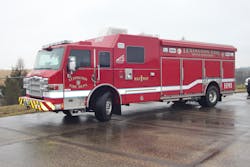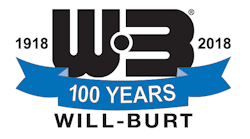Hazmat Studies: Hazmat Response In The Bluegrass Region
Regional hazardous materials response teams were located throughout Kentucky in the late 1980s. By the end of the 1990s, however, many teams had disbanded for various reasons, leaving gaps in hazmat response. Following an infusion of money from the Kentucky Division of Emergency Management, a regional team was formed in central Kentucky in 2001-2002 covering 11 counties – Bourbon, Clark, Estil, Fayette, Garrard, Harrison, Jessamine, Madison, Nicholas, Powell and Woodford. The Bluegrass Emergency Response Team (BERT) became operational in 2004.
Central Kentucky, the state’s Bluegrass Region, includes the Lexington and the capital at Frankfort. The region is known for its horse farms with miles of pristine white fences, rolling fields of bluegrass and Kentucky Horse Park in Lexington, considered the heart of the Horse Capital of the World. Lexington is the second-largest city in Kentucky, with 299,803 residents and a metropolitan-area population of 472,099.
As with many teams today, BERT is are not limited to hazmat and weapons of mass destruction (WMD) response. BERT members are also trained and equipped to respond to rescue operations including rope, cave, trench, confined space, urban search and rescue (USAR), natural disasters, mass-casualty incidents and radiological emergencies. BERT is comprised of local emergency responders from throughout the region. Team members include firefighters, emergency management personnel and police officers who are available at a moment’s notice to help mitigate incidents that are beyond the capabilities and resources of local jurisdictions.
Five vehicles have been designated for team operations. Response equipment is based at the following locations:
• Hazardous materials – Unit 1, Clark County (Winchester Fire-EMS) and Unit 2, Woodford County (Versailles Fire & Rescue)
• Mass casualty – Unit 3, Fayette County (Lexington Fire Department)
• Radiation response – Unit 4, Fayette County (Lexington Fire Department)
• Rescue operations – Unit 5, Jessamine County (Jessamine County District Fire Department in Nicholasville)
• Storm response – Garrard County (District 1 Fire Station in Lancaster), Madison County (Richmond Fire Department), and Nicholas County (Carlisle Fire Station)
BERT has a governing board and team president to oversee its business aspects. The president is Brian Wescott, a full-time firefighter with the Lexington Division of Fire and EMS. An executive board is involved with the day-to-day management along with the president. The team also has a designated training officer.
Team activations
When the team is activated, a designated Hazmat Group Supervisor is responsible for incident activities involving BERT. The Hazmat Group Supervisor reports to the Operations Section Chief. Team members are dispatched by the Lexington dispatch center. Those having the authority to activate BERT are the Kentucky Division of Emergency Management Area 11 Manager (the agency is organized into 11 regions, each with a regional manager); county emergency management directors; fire chief or designee; or BERT president. A call-down system using pagers alerts team members, starting with those already on duty within the county. Jurisdictions within the 11-county area have agreed to let on duty personnel respond to BERT activations. Once alerted, team members respond to pre-assigned duty stations where the vehicles are located for assembly into appropriate response groups. Hazmat Group Supervisors are authorized to respond directly to the scene without first reporting to the duty station, depending on the location of the call.
The minimum hazmat response includes four technicians, two decontamination personnel and sufficient support personnel. If additional personnel are needed, off-duty team members are called in. Approximately 48 personnel are on duty at paid departments throughout the 11 counties at any time. About 150 trained technicians are on the team. If additional resources are needed, statewide mutual aid agreements are in place among all counties. Blue Grass Airport in Lexington is home to a regional training center for aircraft rescue and firefighting (ARFF). Resources at the airport and training center are also available to BERT.
BERT members respond to an average of 27 hazmat incidents each year, not including fuel spills, gas-odor complaints or carbon monoxide (CO) alarms that are handled by local jurisdictions. Fire department engine companies carry absorbent materials for small fuel spills. Procedures for calling in BERT for fuel spills vary from county to county.
BERT qualifications
The BERT governing board determines team membership and votes in new members. Membership applications are assessed for training level and certificates, availability for response, residence (members must live in the BERT response area), employers’ statements of availability and applicants’ statement that they have read and understand all BERT procedures. Once approved, each applicant must undergo a medical examination to determine fitness for duty based on the physical requirements of BERT operations. Team members may be trained to any of the National Fire Protection Association (NFPA) and Occupation safety and health Administration (OSHA) hazmat levels, including awareness, operations, technician, specialist or incident commander. Hazmat duties on the team depend on members’ levels of training:
• Awareness-level personnel receive sufficient training or proven experience in specific competencies
• Operations-level personnel require awareness-level training plus 16 hours or proven experience
• Technicians receive awareness and operations training plus 16 hours of initial training and proven competency in specific areas
• Hazardous Materials Group Supervisors must be qualified at the technician level plus have 16 hours of incident command training and proven competency
All BERT personnel receive annual refresher training to maintain competency. Entry team leaders are required to be at the technician level with additional competencies identified in team standard operating guidelines (SOGs). A person designated as an Assistant Safety Officer/Hazardous Materials is required to be at the technician level and have competency in areas listed in team SOGs. Training for team members is conducted by OAI Inc. and paid for through grants.
On arrival at an incident scene, the Hazmat Group Supervisor is responsible for organizing BERT according to team SOGs and becomes a part of the overall incident management system already put in place by the local jurisdiction. Depending on the scope of the incident and the needs of the Hazmat Group Supervisor, they may appoint an Entry Leader; Decon Leader; Site Access Control Leader, Assistant Safety Officer/Hazardous Materials; Technical Specialist/Hazardous Materials Reference; and Safe Refuge Area Manager. Any functions that are not designated by the Hazmat Group Supervisor will be handled by the Hazmat Group Supervisor.
Equipping the team
Hazmat equipment carried by BERT is typical of hazmat response teams. For physical protection, members use Lakeland Tychem TK Level A and B chemical protective suits, Cool Vests body-cooling vests and Scott 4.5 60-minute airpacks with longline connections.
Lexington’s Hazmat 1 is a 2009 Pierce with a command cab, 25-kilowatt Onan generator, WTI Sidewinder telescoping zoom video camera and Will-Burt Night Scan light tower. The unit is equipped with climate-controlled chemical protective equipment and air monitor storage compartments. Three video monitors are in the command cab – one for video output, one for real-time local weather radar and one for an EntryLink video camera. An external computer and video monitor provide video to team members outside the command cab for briefings and other needs. DVR capability is available in the command cab to record and play back video camera footage. Two desktop computers and wireless Internet connections are available for research.
Two hazmat trailers are pulled by pickup trucks in Clark and Woodford counties and are capable of handling hazmat response on their own if required. Winchester Fire-EMS (Clark County) houses Unit 1 and the Versailles Fire Department houses Unit 2. Command centers are located at the front of the trailers and team equipment in the rear. Equipment carried on the trailers includes Level A and B chemical protective suits and related equipment; self-contained breathing apparatus (SCBA) and spare 60-minute bottles; AV3000 air-purifying respirators (APRs); N100 cartridge masks; decontamination equipment and supplies; patching and plugging equipment; and a multitude of other tools and support equipment for use during hazmat responses. Monitoring equipment includes Cannonball 3, MultiRAE and Passport monitors; Smiths Detection LCD-3 chemical detector and HazMatID system; and Inspector radiation monitor.
Hazmat exposures
Hazardous materials fixed-facility exposures in the BERT response area include bulk petroleum fuel facilities, Avantor Performance Materials, GE Lamp and University of Kentucky Research Facilities. Transportation exposures include Interstates 64 and 75 and the CSX, Norfolk Southern and Central Kentucky Line railroads.
Major natural gas and petroleum pipelines are also in the response area. Major chemical exposures include hydrogen fluoride (HF), radioactive waste from Tennessee, mustard and nerve agents from the Bluegrass Army Depot, pesticides, propane, chlorine and anhydrous ammonia.
For additional information, contact BERT President Brian Wescott at 859-582-0570.
ROBERT BURKE, a Firehouse® contributing editor, is a Certified Fire Protection Specialist (CFSP), Fire Inspector II, Fire Inspector III, Fire Investigator and Hazardous Materials Specialist, and has served on state and county hazmat teams. Burke is the author of the textbooks Hazardous Materials Chemistry for Emergency Responders and Counter-Terrorism for Emergency Responders. He can be contacted at [email protected].








